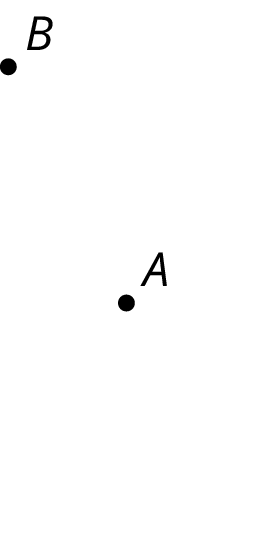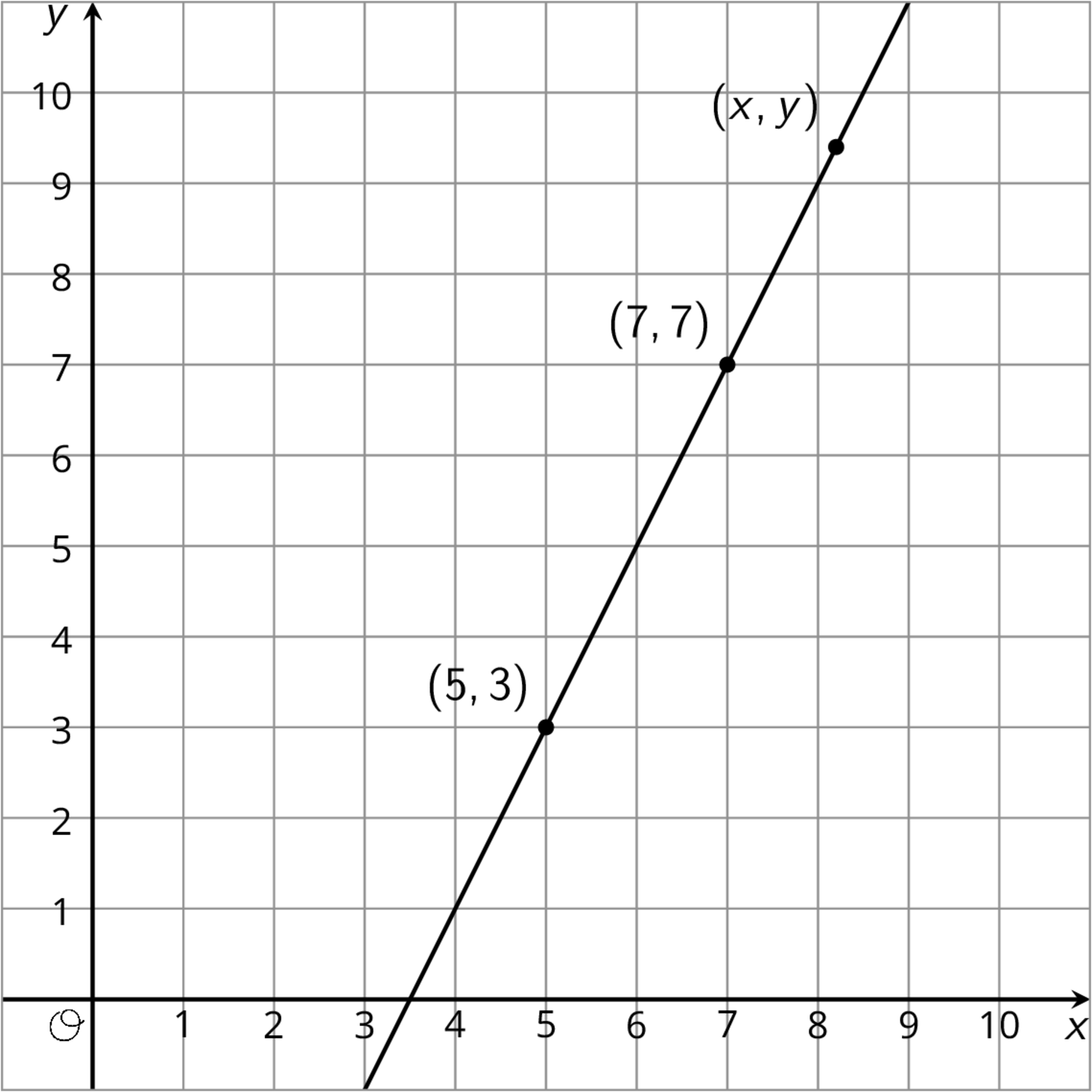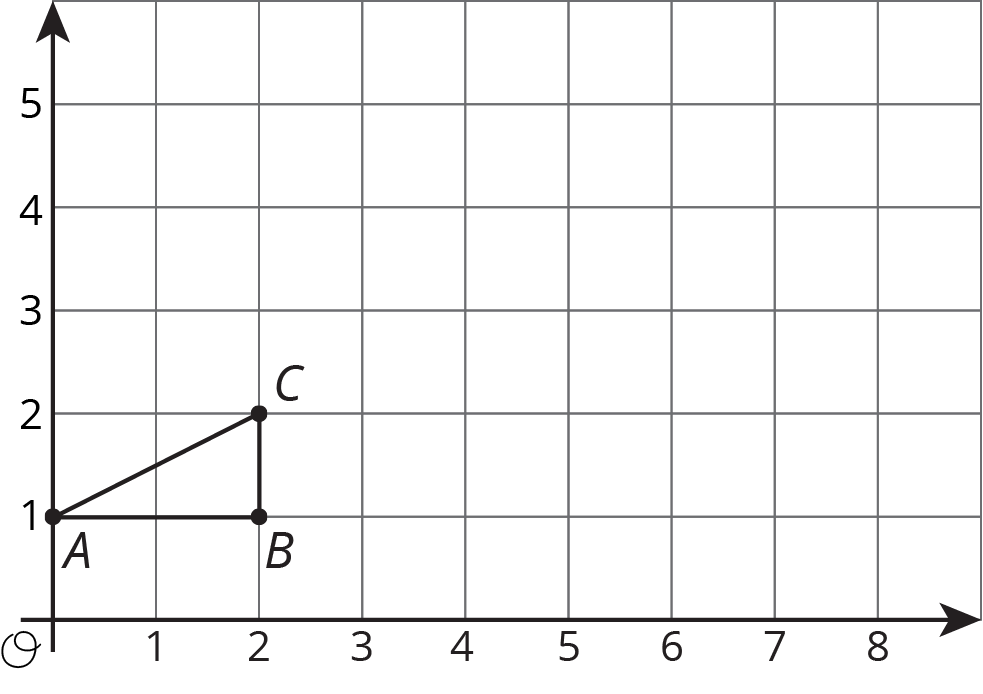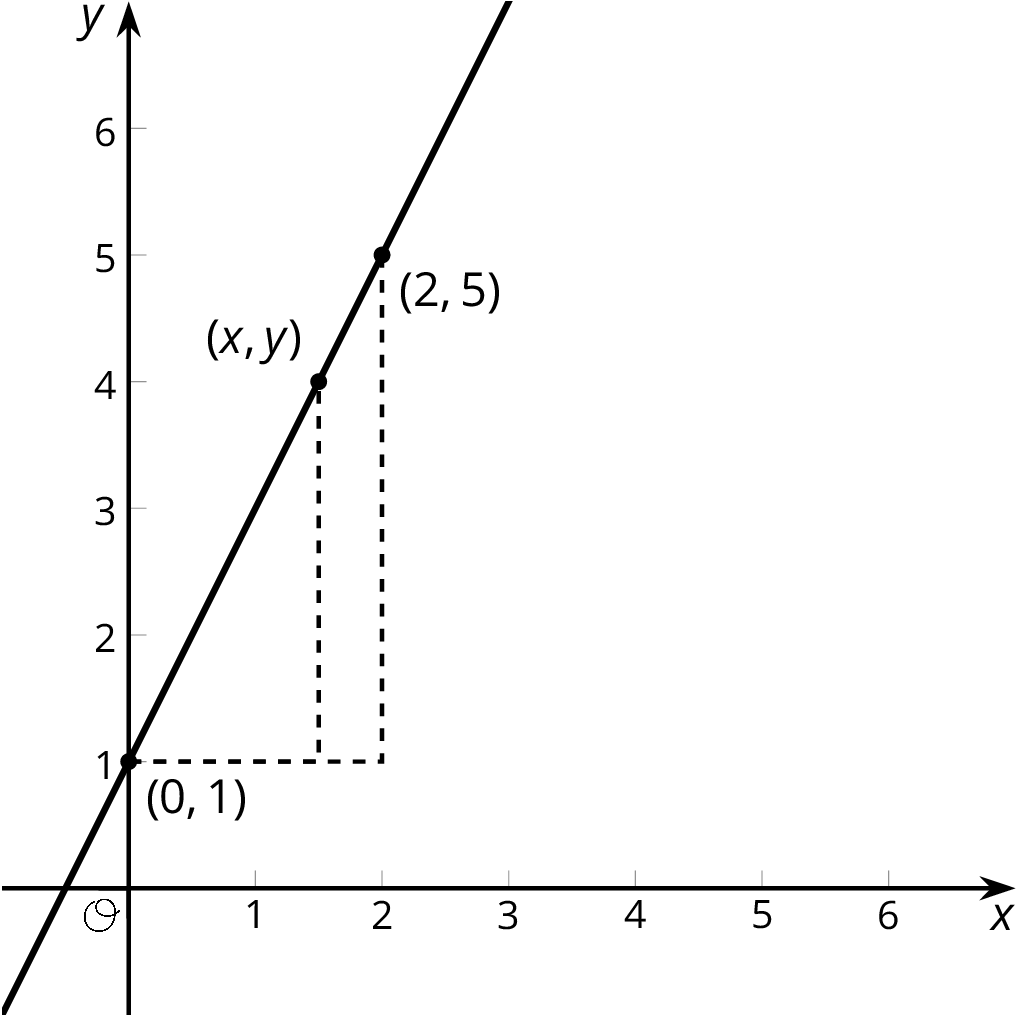Lesson 12
Using Equations for Lines
12.1: Missing center (5 minutes)
Warm-up
Given a point, the image of the point under a dilation, and the scale factor of the dilation, students must identify the center of the dilation. This requires thinking about the meaning of dilations and the fact that the center of dilation, the point dilated, and the image, are collinear.
Launch
Provide access to geometry toolkits. (In particular, a ruler or index card is needed.)
Student Facing
A dilation with scale factor 2 sends \(A\) to \(B\). Where is the center of the dilation?

Student Response
For access, consult one of our IM Certified Partners.
Activity Synthesis
Ask students what they know about the center of dilation that helps to solve this problem. The key fact is that the center of dilation lies on the same line as \(A\) and \(B\). The scale factor is 2 so if \(P\) is the center of dilation, then the length of segment \(PB\) is twice the length of segment \(PA\).
12.2: Writing Relationships from Two Points (10 minutes)
Activity
In the previous lesson, students found an equation satisfied by the points on a line using properties of slope triangles and a general point, labeled \((x,y)\), on the line. In this activity, they pursue this work but the scaffold of the given slope triangles has been removed. Once students draw appropriate slope triangles, this is an opportunity to practice and consolidate learning. In addition, students use the equation (satisfied by points on the line) to check whether or not specific points lie on the line.
Note that the \(y\)-intercept was intentionally left off of this diagram, so that students who may have seen some of this material are discouraged from jumping straight to \(y=mx+b\) and encouraged to engage with thinking about similar triangles.
There are many slope triangles that students can draw, but the one joining (5,3) and (7,7) is the most natural for calculating the slope and then \((x,y)\) and either \((5,3)\) or \((7,7)\) can be used to find an equation. Monitor for students who make these choices (and use them to decide whether or not the given points lie on the line) and invite them to present during the discussion.
Launch
Provide access to geometry toolkits (in particular, a straightedge is helpful). Give 2–3 minutes of quiet work time. Then ask them to share their responses and reasoning with a partner, followed by a whole-class discussion.
Supports accessibility for: Conceptual processing; Visual-spatial processing
Student Facing
Here is a line.

- Using what you know about similar triangles, find an equation for the line in the diagram.
- What is the slope of this line? Does it appear in your equation?
- Is \((9, 11)\) also on the line? How do you know?
- Is \((100,193)\) also on the line?
Student Response
For access, consult one of our IM Certified Partners.
Student Facing
Are you ready for more?
There are many different ways to write down an equation for a line like the one in the problem. Does \(\frac{y-3}{x-6}=2\) represent the line? What about \(\frac{y-6}{x-4}=5\)? What about \(\frac{y+5}{x-1}=2\)? Explain your reasoning.
Student Response
For access, consult one of our IM Certified Partners.
Activity Synthesis
Invite selected students to show how they arrived at their equation. Also, ask them how the equation helps to determine whether or not the points in the last two questions lie on the line. Emphasize that the graph, as shown, is not helpful for checking whether or not \((100,193)\) is on the line, but the equation is true for these numbers, so this point must be on the line.
Highlight that using \((x,y)\) and \((5,3)\) for a slope triangle gives an equation such as \(\frac{y-3}{x-5}=2\) while using \((x,y)\) and \((7,7)\) gives the equation \(\frac{y-7}{x-7}=2\). These equations look different, but they both work to check whether or not a point \((x,y)\) is on the line. Using algebra to show that these two equations are equivalent is not necessary (or appropriate in grade 8), but students can see from the picture that either equation can be used to test whether or not a point \((x,y)\) is on the line. If students have not done so already when they share their solutions, draw and label the two slope triangles that correspond to these two equations.
Design Principle(s): Optimize output (for explanation); Maximize meta-awareness
12.3: Dilations and Slope Triangles (15 minutes)
Activity
This activity investigates the coordinates of points on a line from the point of view of dilations. At the beginning of this unit, students experimented with dilations and made numerous important discoveries including
- Dilations change distances between points by a scale factor \(s\).
- Dilations preserve angles.
- Dilations take lines to lines.
Having developed the key ideas of similar triangles and slope, this activity returns to dilations, applying them systematically to a single slope triangle. All of these dilations of the triangle are similar, their long sides all lie on the same line, and the coordinates of the points on that line have a structure intimately linked with the dilations used to produce them.
For the third question, monitor for students who
- look for and express a pattern for the coordinates of the points from earlier questions (MP8); a scale factor of 1 gives \(C = (2,2)\), a scale factor of 2 gives \(C = (4,3)\), a scale factor of 2.5 gives \(C = (5,3.5)\), so the \(x\)-coordinate appears to be twice the scale factor while the \(y\)-coordinate appears to be one more than the scale factor.
- use the structure of \(\triangle ABC\) and the definition of dilations.
For the final question, students can either
- reason through from scratch, looking at the \(x\)-coordinate or \(y\)-coordinate for example or
- use the coordinates they find for a scale factor of \(s\) in the third question.
Monitor for both approaches and invite students to share during the discussion.
Launch
Access to geometry toolkits. Give 2–3 minutes of quiet work time, then ask students to share their reasoning with a partner. Follow with a whole-class discussion.
Supports accessibility for: Conceptual processing; Language
Student Facing
Here is triangle \(ABC\).

- Draw the dilation of triangle \(ABC\) with center \((0,1)\) and scale factor 2.
- Draw the dilation of triangle \(ABC\) with center \((0,1)\) and scale factor 2.5.
- Where is \(C\) mapped by the dilation with center \((0,1)\) and scale factor \(s\)?
- For which scale factor does the dilation with center \((0,1)\) send \(C\) to \((9,5.5)\)? Explain how you know.
Student Response
For access, consult one of our IM Certified Partners.
Activity Synthesis
First, focus on the third question, inviting selected students to present, in this sequence: first those who identified a pattern from the first two questions and then those who studied the impact of a dilation with scale factor \(s\) on \(\triangle ABC\). Point out that the argument looking at where \(C\) is taken by the dilation with scale factor \(s\) and center \(A\) explains why the \(x\) coordinate doubles and the \(y\) coordinate is 1 more than the scale factor.
Next, invite selected students to share their answers to the last question.
In previous activities, students have used similar triangles to show that the points \((x,y)\) on the line containing the long side of triangle \(ABC\) satisfy the relationship \(\frac{y-1}{x} = \frac{1}{2}\). In this activity, they find that points \((x,y)\) on this line are of the form \((2s, s+1)\) where \(s\) is a (positive) real number. Make sure that students understand that the equation \(\frac{y-1}{x} = \frac{1}{2}\) is true if we take \(y-1 = s+1\) and \(x = 2s\). Also, emphasize the key role that dilations play in these arguments.
The big take away from this lesson is that the structure of the coordinates of points on a line can be derived from properties of dilations.
Design Principle(s): Maximize meta-awareness, Cultivate conversation
Lesson Synthesis
Lesson Synthesis
The coordinates of points on a line have a nice structure that is useful for checking whether or not a given point is on a line. Here is a line with a couple of labeled points.

- What is the slope of this line? It’s \(\frac{1}{2}\) because a slope triangle (draw in the slope triangle) for the two labeled points has horizontal side length 4 and vertical side length 2.
- What is an equation for the line? One example is \(\frac{y-2}{x-2} = \frac{1}{2}\). Label a general point on the line \((x,y)\), and draw in a slope triangle to show this relationship.
How can we find out whether or not the point \((72, 37)\) is on this line? The points on the line satisfy the equation \(\frac{y-2}{x-2} = \frac{1}{2}\). Since \(\frac{37-2}{72-2} = \frac{1}{2}\), the point \((72,37)\) is on the line!
12.4: Cool-down - Is the Point on the Line? (5 minutes)
Cool-Down
For access, consult one of our IM Certified Partners.
Student Lesson Summary
Student Facing
We can use what we know about slope to decide if a point lies on a line. Here is a line with a few points labeled.

The slope triangle with vertices \((0,1)\) and \((2,5)\) gives a slope of \(\frac{5-1}{2-0} =2\). The slope triangle with vertices \((0,1)\) and \((x,y)\) gives a slope of \(\frac{y-1}{x}\). Since these slopes are the same, \(\frac{y-1}{x} = 2\) is an equation for the line. So, if we want to check whether or not the point \((11,23)\) lies on this line, we can check that \(\frac{23-1}{11} =2\). Since \((11,23)\) is a solution to the equation, it is on the line!